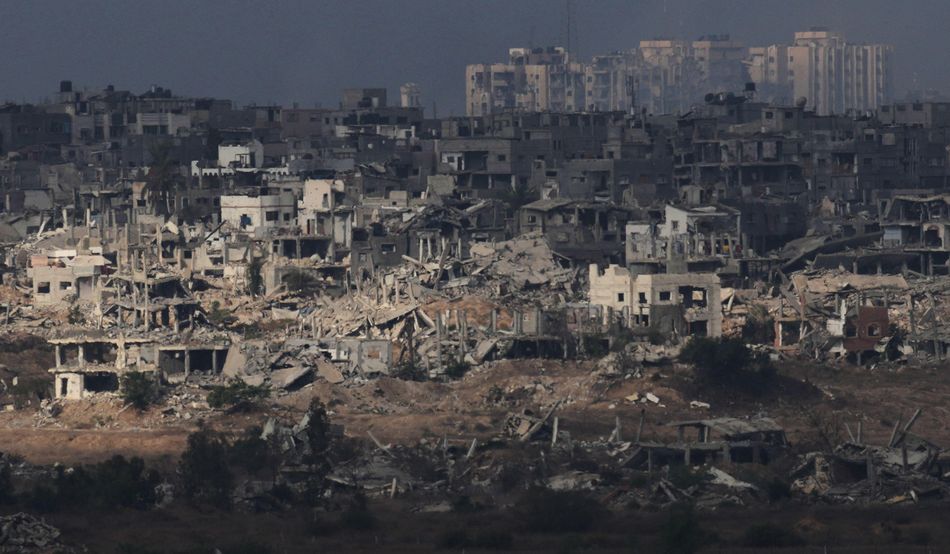In July 2012, Prospect published an article in which I listed the ten rules I saw as responsible for the many failures to resolve the long-running Israeli-Palestinian conflict. These rules had led me to the conclusion that there might never be peace.
Has Donald Trump nevertheless found a way through, with the Gaza ceasefire deal he trumpeted to the Israeli Knesset on 13th October as the historic dawn of a new Middle East?
Rule 1: “The worst thing will always happen at the worst possible time”
I developed this rule in part prompted by my gloomy assessment of the 1995 assassination of Israel’s prime minister, Yitzhak Rabin, at the hands of a right-wing extremist. Not only had this tragic event holed the 1993 Oslo peace agreement below the waterline, but it might even have extinguished hope of a two-state solution. The point now seems to me a more general one. It is about the importance of timing—and about the leadership skill involved in spotting the moment when you can move forward to resolve long-running conflicts, such as in Northern Ireland. Finding an opportunity is, perhaps, related to the warring sides realising that they are in a mutually exhausted stalemate.
Trump and his team of advisers deserve full marks for spotting a moment of opportunity at least to achieve a ceasefire in Gaza. They drew on elements which had been on the table for many months and perhaps capitalised on both the Israeli army and Hamas being badly in need of a rest. The Americans additionally received a much-needed boost—and critical input—from several countries in the region who are not always so helpfully aligned.
Trump also appears to have spotted that the time was right to put some serious pressure on Israel. The war was in effect becoming one of self-destruction. This was in terms of Israel’s standing in the world, but it may also have reflected a perception in some parts of the US administration that Israel’s sustainability as a Jewish state (and indeed US standing in the region) is threatened by the prospect of Israeli annexation of at least parts of the West Bank, and the consequent definitive end of a two-state vision. And Netanyahu surely miffed the Americans with his attack on Hamas negotiators in Doha, which undermined diplomatic efforts to achieve a ceasefire and struck the territory of an important US ally. It may also be true that the decision by the UK, France and others to recognise a Palestinian state—even if driven by domestic (and sometimes disturbingly antisemitic)—political pressures, rather than with a realistic eye to whether such gesture diplomacy might make any difference on the ground, added to the understanding about Israel’s international isolation.
But of course it may simply be that both the Israel Defence Forces (IDF) and Hamas reckon they need a breather, rather than either side believing that the ceasefire will pave the way to the end of the war. Netanyahu in particular may be counting on Hamas’s misbehaviour to give him an excuse to back away from the deal. After all, he only signed up to it under pressure, and it is deeply unpalatable to some key members of the coalition on which he depends for his political survival.
In other words, however tough it has been to get where we are, the going will only get tougher from here on in. It will need sustained top-level American political drive and—just as important—pragmatism, as well as a continued more-or-less joined-up international effort to turn this moment of opportunity into a long-term peace.
Rule 2: “Everyone is afraid of being a sucker”
In my 2012 article, I assessed that both Israelis and Palestinians believed—rightly or wrongly—that the concessions they had made in the past had not been reciprocated. They were therefore determined not to be taken for a ride in the future. This is indeed a key element in the toxic legacy of the past.
But while I think this rule still holds, what strikes me today is again a more general point about political leadership. Great leaders, or great statesmen, like South Africa’s Mandela and de Klerk, not only come to understand the need for compromise and empathy—the need to listen to the other side. They have the courage and stature to make the case to their constituencies whatever the immediate risk to their reputations or indeed even—as in the case of Rabin—to their lives. They have the courage, in other words, to be accused of being weak.
This is a rare quality in any leader, in any country. It is perhaps particularly difficult in Israel, which has had to fight since its birth for its continued existence. But the reality remains that only a two-state solution could do justice to the incompatible national aspirations of the Jewish and Palestinian populations, who live uneasily together on a small piece of land. The British in the Mandate era did not openly acknowledge this until the 1937 Peel Commission recommended partition of Palestine. And until the leaders of both those populations can state that reality clearly, and listen empathetically to the other side’s “story”, violence and failure are virtually inevitable.
Netanyahu is not the man to take such a road. On the Palestinian side, Yasser Arafat never fully abandoned the path of violence and the Palestinian president, Mahmoud Abbas, is a busted flush. Meanwhile, Hamas’s actions on 7th October 2023 sent a message to most Israelis that whatever the group said about its revised charter (the group updated its founding document in 2017, removing some of the original’s more overtly antisemitic language), its agenda remains a Jew-free zone “between the river and the sea”.
I know many Israelis and many Palestinians who see the situation with the clarity required. But I have yet to be convinced that any of them have the charisma and leadership to persuade their people that the least of the long-term risks they face is that of being accused of being a sucker.
Rule 3: “Only the Americans can, and the Americans can’t”
Trump’s deal illustrates that this rule still holds. Certainly, only the Americans have the weight to knock heads together, and to convene the sort of gathering that took place in Sharm el-Sheikh on 13th October, where regional and other leaders loitered until Trump turned up several hours later, fresh from his triumphal appearance in Israel’s parliament.
But while point 19 of Trump’s 20-point Gaza peace plan recognises Palestinian self-determination and statehood as the aspiration of the Palestinian people, the phrasing falls far short of a ringing American endorsement of such an aspiration. Netanyahu has of course already made clear that a Palestinian state is not on his agenda. The Trump administration’s denial of a visa to Abbas to address this year's UN General Assembly sent a clearer message about the extent to which Washington doesn’t get the Palestinian narrative, and their sense of dispossession and Western double standards. Nor does the US appear to understand the need for meaningful Palestinian agency in any unfolding peace process.
On the other hand, it is after all only Washington’s courage and military and other support to Israel which has ensured the survival of the latter over the decades. A hard-headed American approach might have been that its long-term interests lay more with the Arab world. It is not as though anyone else could play the critical intermediary role, however, though some European countries might like to. Too many of them can be accused both of a historical failure to provide a safe home for their Jewish populations, culminating in the horror of the Shoah, and of failing to provide unambiguous support to a state their own shortcomings made necessary.
Rule 4: “It’s easier for a right-wing government to make peace than a left-wing one” (a rule sometimes called “only Likud can”)
It is often easier for hardliners to strike the tough deals than it is for those perceived as starting from a more conciliatory position. Politicians such as Rabin and Shimon Peres, for example, were always at risk of being accused of unnecessary appeasement by the radical right, whereas Menachem Begin could give back the Sinai to Egypt, and Ariel Sharon could pull out of Gaza.
But Sinai was not part of Eretz Israel, the Biblical homeland. And while neither was Gaza, Sharon had to break with his political party, the right-wing Likud, to push through the Gaza withdrawal decision.
I do not see Netanyahu as a man with such courage, although arguably he might now reinvent himself and campaign at the next elections (on the back of the Gaza ceasefire deal and Israeli achievements in the region) as a peace leader rather than a war leader. But he could not do so and hold anything like his current coalition, quite apart from his own party, together, particularly with the likes of the extremist Israeli ministers Itamar Ben-Gvir and Bezalel Smotrich both openly pursuing a maximalist “Greater Israel” agenda and keen to encourage Palestinian emigration. And Netanyahu’s own ideological background, hailing from a right-wing, maximalist Zionist tradition, means in my view, that he would be unable to contemplate the necessary compromises on Jerusalem in particular, without which no Palestinian leader could accept a final package.
And there is also the growing political weight of the settler movement, even if not all the 700,000 or so Israeli Jews living in East Jerusalem and the West Bank are there for committed ideological reasons. The increasing number of outposts and settlements, and the accompanying infrastructure, was indeed one of the reasons I concluded when I left Israel in 2010—albeit hoping then, as I do now, that I was wrong—that a two-state solution was no longer achievable. And there is nothing in the 20-point plan to address this issue, nor that of the reported steady rise in settler violence since 7th October.
Rule 5: “Incrementalism doesn't work”
Peace processes to date have invariably been designed to leave the toughest issues (Jerusalem and the “right of return” of Palestinian refugees and their descendants) to last. But that envisaged incrementalism is also responsible for the Palestinian mantra that “nothing is agreed until everything is agreed”. No Palestinian leader will risk being suckered by signing up to other less important elements of a deal, only to have the door shut on any discussion of these two items later on.
At the same time, 7th October has made it harder even for many in the Israeli peace camp to contemplate upfront a Palestinian state, particularly one fully based on the 1967 armistice lines. Who can blame Israelis for worrying about what would happen if a Hamas or Hamas-lookalike government were voted into power, with its capital in East Jerusalem?
Rule 6: “It's all about Jerusalem and the right of return”
But even if incrementalism—in the name of gradual confidence-building—is inevitable, it can only work if both sides signal from the start that they are prepared to go all the way to a two-state solution, and that the endgame deal will have to cover the Jerusalem and refugee issues. These lie at the heart of each side’s existentially critical narrative: the Jewish vision of return to a rebuilt Jerusalem, and the Palestinian sense of dispossession.
There may indeed be a link between these two issues, in terms of a final trade-off: the Israelis accepting a Palestinian capital in East Jerusalem (with Jerusalem as a whole remaining an open city of some kind), and the Palestinians accepting only a very limited right of return. Or even—as proposed by former prime minister Ehud Olmert in his 2008 offer to Abbas—renouncing the “right” while Israel would allow a small number of returns on a humanitarian basis.
Rule 7: “There cannot be a deal on sovereignty in the Old City”
A key element of the Olmert proposal (which in my opinion remains a major missed opportunity) is what he envisaged for Jerusalem.
Under that peace offer, each side would be able to claim parts of the city as their capital, while administration of the Holy Basin—including the Old City and the Temple Mount/Haram al-Sharif complex, the nuclear bomb at the heart of the Israeli/Palestinian issue—would be handed over to a committee of trustees consisting of Israel, Palestine, Saudi Arabia, Jordan and the US.
Olmert’s offer was, in a way, a belated recognition of the wisdom of the UN 1947 partition plan, which envisaged Jerusalem as a whole as a “corpus separatum”.
Such a formula is the only way a compromise might be possible. Both Jews and Arabs feel an existential link to the sites in the Old City, and so some arrangement has to be found that ducks the sovereignty issue, given that neither side can concede sovereign rights to this particularly holy patch of land.
It is remarkable that Olmert, a politician originally from the right of the Israeli spectrum, made the journey which led him to understand that only such an approach might lead to a sustainable peace. And it is tragic that, as things stand, we are light years away from anyone seriously resurrecting such a proposal. Hamas’s savagery on 7th October has made it even harder for any Israeli politician to make the same journey.
Many continue to insist that the Israel-Palestine conflict is above all a political struggle over territory and that it is dangerous to describe it in religious terms. For me, however, the centrality of Jerusalem highlights that the conflict has an important religious element. It is of course a struggle over real estate, but that real estate is charged with meaning. I would argue that Israel was simply incapable of doing the wise thing and offering the Palestinians (whom in 1967 they could claim to have liberated from a Jordanian occupation) a partnership state, because at some profound level they were overwhelmed by the prospect of return to the Biblical kingdoms of Judea and Samaria. Jerusalem has particular meaning for Palestinian Muslims, including as the destination of Muhammad’s miraculous flight from Mecca on his steed Buraq. For Palestinian Christians, it is where Jesus was crucified and resurrected. Israeli Jews will argue, with some justification, that their roots to the city go deepest of all, but that is to ignore what the city has come to mean over time.
And somewhere in the mix of US support for Israel is the Evangelical belief that only after the Jews have returned to Israel will Jesus make his Second Coming. Israel’s survival is a core element of their interpretation of history and their existential identity.
These are complex and deep-seated issues. But I do not think we should be afraid of them. Indeed, in my time in Israel I reached the conclusion that, at any particular point of historical time, there may be more scope for theological compromise on who owns the land than politicians are aware of. The interfaith dialogue included in Trump’s 20-point ceasefire plan, whether or not simply slipped in by Tony Blair who undoubtedly understands this dynamic, could be important.
Rule 8: “The difficulty of reaching a deal is compounded by the dysfunctional political systems on both sides”
I noted in 2012 how easy this rule was to illustrate on the Palestinian side, with the sometimes violent divide between Fatah and Hamas. Since then, there has been the growing issue of the legitimacy or otherwise of President Abbas and the Ramallah-based Palestinian Authority (PA), given the lack of any recent evidence of electoral support, as well as the perception among young Palestinians in particular that the PA has become a corrupt, collaborator regime. The last time Palestinians voted was in 2006. Holding elections under occupation is not easy, but the Palestinian failure to unite political forces and speak with a single voice to Israel and the international community is a major one. Abbas himself seems to have been a main obstacle to any meaningful implementation of the 2024 Beijing Declaration, an agreement for Palestinian unity which was the outcome of a negotiation between the various Palestinian factions. On paper at least this could have paved the way to reconciliation between Fatah and Hamas.
A major worry now is that Hamas’s ruthless suppression of opposition in Gaza and other misdemeanours will once again expose the fault-lines in the Palestinian body politic. This would give Netanyahu all the reasons he needs to pull the brake on the Israeli side of implementation of the ceasefire deal, long before anyone gets round to talking about issues such as whether there should ever be a Palestinian state.
And it looks wholly unrealistic to expect Hamas both to disarm, as the ceasefire deal stipulates, and to play no role in the governance of Gaza. Such armed groups are only prepared to take the risk of surrendering their weapons if they are offered a viable political route to achieving at least some of their objectives. Until Hamas believes it could play such a role it will surely refuse to lay down its arms.
Is Hamas prepared to make the same kind of transformation as the IRA did in Northern Ireland? Optimists will point for instance to the (far from wholly unambiguous) wording in Hamas’s revised charter and to the Beijing agreement as evidence that Hamas is on a journey and might be willing to go down such a route. Pessimists would argued that one need look no further than the 7th October attack.
I do not know how much support Hamas still has in a Gaza flattened as a predictable consequence of the group’s actions. There have been suggestions that a weakened Hamas would be prepared to accept some kind of “front” Palestinian governing body in Gaza, as long as they could continue to play a more behind-the-scenes political role, although that would be at odds with Trump’s 20-point plan. But some in Hamas may even assess that the war to-date has been a strategic victory, in putting the Palestinian issue back on the international agenda; highlighting the irrelevance of the Ramallah PA; and deepening Israel’s international isolation.
This could be where Turkey and Qatar prove critical. Whereas the Saudis, the Emiratis, the Egyptians and others thoroughly dislike Hamas as an offshoot of the Muslim Brotherhood, both Turkey and Qatar have cultivated a relationship with the group. They may now be prepared to exert significant pressure on it to compromise. But to imagine that Hamas can be written out of the story looks to me like wishful thinking.
On the Israeli side, the low threshold proportional representation system continues to mean a proliferation of political parties and fragile coalition governments, which invariably contain some who will oppose any forward movement on the Palestinian front. All this against the background of a long-term shift to the right in the Israeli population as a whole.
Rule 9: “The international community has never wanted it enough”
Without going too far back into history, the international community has for too long put the Israeli/Palestinian issue in the “too difficult” tray, happy to leave it to the Americans despite knowing that the Americans were essentially parti pris and would never be fully trusted by the Palestinians.
The 7th October attack was—as Hamas perhaps intended—a wake-up call that the Israeli-Palestinian issue could no longer be ignored. So the 13th October Sharm el-Sheikh gathering mattered if it symbolised the start of a new determination by all parties to apply coordinated pressure along every difficult step of the 20-point plan. It was particularly significant in involving countries from the region since, despite the Abraham Accords, the Israelis need to understand that their ultimate acceptance in the Middle East will only happen if there is a sustainable Israeli-Palestinian peace deal, almost certainly involving the creation of a Palestinian state.
The Saudis hold the key. Like many other elites in the region, the ruling elite have no special liking for the Palestinians. They remember Arafat’s support for Saddam Hussein and his endless begging bowl visits, and they know that Israeli military and intelligence capabilities could help them to keep Iran in its place. They also know that the possibility of opening diplomatic relations with Israel gives them serious leverage in Washington.
But holding the Sharm coalition together will be tough, and it will only happen if it driven from the top by the US. This week, the king of Jordan told the BBC that his country and Egypt are only prepared to contemplate their troops playing a peacekeeping role in Gaza in support of a Palestinian police force, and not a peace-enforcement role. This confirms that at least some in the Arab world are already developing understandable cold feet at the prospect of putting boots on the ground in Gaza before Hamas has been disarmed (and who by, if not by Israel, and at the cost of the end of the ceasefire?)
And why should they foot the bill for the reconstruction of Gaza before progress on the political track convinces them that the Strip will not be flattened when the next round of fighting flares up? Even the Europeans may not be that stupid.
Rule 10: “Failure is the most likely outcome”
This remains my reluctant view. I continue to think that it is too late for a two-state solution even if that would have been the right solution. I do not see any sustainable alternative, although it is striking that figures such as former politician Yossi Beilin, who played a key role in the Oslo Accords, are now re-floating the idea of some kind of confederation with Jordan. But anything other than a full two-state deal will I think inevitably fail on the issue of who actually controls what.
I find it interesting, too, that a growing number of young Palestinians are also concluding that the window of opportunity for a two-state solution has closed. They are turning their minds to a struggle for full political, economic and social rights in one state. But such an outcome remains unthinkable for most Israelis, and indeed as yet for most Palestinians, even if Israeli government policies and the settlement movement have prompted this shift.
So, failure, and continued conflict, remain the most probable scenarios—perhaps unless the two-year-long Gaza crisis really has served as a wake-up call to everybody, that this issue is too dangerous to be allowed to fester any longer. And I remember the mantra that some of us used to whisper in the corridors of the Foreign Office as we contemplated the turbulent world: Hope is not a strategy, but despair should never be an option.
Still, the way ahead remains dauntingly difficult. So in the unlikely event that Trump can pull off a fair and sustainable long-term peace, he will certainly deserve the Nobel Peace Prize.














